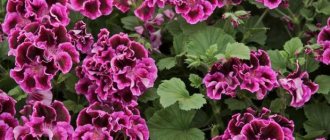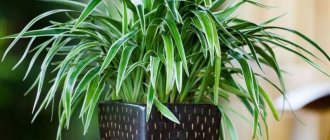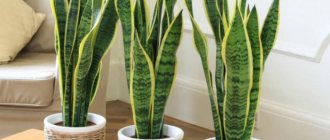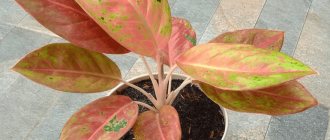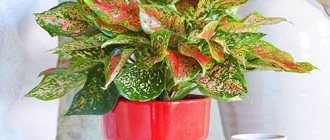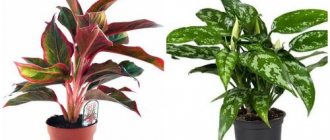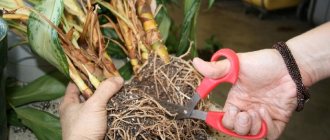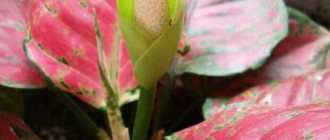floravdome.ru > Aroids > Aglaonema - Growing at home
A beautiful and fairly unpretentious plant, Aglaonema, is perfect for growing in offices and indoor gardening. The main thing is to choose the right variety, since varieties of this spectacular flower may differ slightly in terms of placement and care.
The name Aglaonema translated from Greek sounds like: aglala - shine + nema - thread.
Belongs to the Araceae . Homeland - China and Southeast Asia. It grows on river banks, in tropical forests in the shade of trees. The plant is able to survive and adapt to the most unfavorable conditions.
Aglaonema
Description of Aglaonema
There are more than 50 species and many decorative hybrids that are perfect for indoor growing.
The height of the plant is up to 80 cm. The leaves are large, dense, 10-15 cm long, on long petioles, growing from the trunk, most often of an elongated oval shape, but there are species with narrow long leaves up to 25 cm. The most common leaf color is rich green colors with large spots of a pale silver-green hue.
Varieties have been developed with leaves covered with chaotically located spots of red, orange, pink flowers on a green background, with bright contrasting veins or completely red leaves.
The flowers are yellow-green, the cob, the fruits are red, sometimes light-colored berries, but this plant is still valued for its beautiful variegated leaves.
Aglaonema
Aglaonema is undoubtedly a useful plant. It releases phytoncides that cleanse the air of harmful impurities at home and in office premises, especially in those where synthetic materials and a lot of office equipment predominate.
It has a beneficial effect on the human condition, increasing stress resistance and performance.
Improves the overall energy of the room.
It must be remembered that the plant juice and fruits are poisonous . Broken leaves release poisonous juice, so carry out all procedures for removing leaves or replanting with gloves and wash your hands thoroughly after work.
Place out of the reach of children and animals!!!
Alaonema varieties
Photo gallery
Like most aroids, the juice of Aglaonema is caustic; its leaves cannot be tasted. Don't let children experiment with the plant.
This bush works as a natural air purifier. Its foliage absorbs harmful volatile compounds that evaporate from polished or plastic surfaces (phenol, benzene, formaldehyde). It is believed that the phytoncides produced by aglaonema leaves kill streptococcus.
Aglaonema flowering
From June to August. The flowers are inconspicuous - the spadix is light-colored and covered with a pale green color.
When flowering, the decorative effect of the leaves is partially lost, so it is recommended to remove the flowers.
Aglaonema flower
Seeds
We plant them in a mixture of sand and peat in a greenhouse, watering them regularly. We sow immediately as we harvest. The first shoots appear after 2-3 months. When propagated by seeds, a new plant almost never retains varietal characteristics.
By cuttings
We cut off part of the stem, divide it into parts up to 10 cm, each should have leaves. We treat the sections with charcoal and plant them in a mixture of peat and sand. We create greenhouse conditions and place them in a bright, warm (+25° - +26°) place. Periodically ventilate and moisten. Rooting within 3 weeks.
Side shoots take root well - in water, with the addition of Epin (or another growth stimulant).
Dividing the bush
When transplanting, only mature plants. To prevent root rot, the roots are subsequently washed before dividing, and after dividing, the cut sites are sprinkled with coal.
Can I keep it at home?
A representative of the Araceae family remains a novelty for many Russians today.
Is it possible to keep it at home? Many people refuse this easy-to-care-for ornamental plant because of its poisonous qualities. The fruits and nectar are really not safe for humans. If simple rules are followed, the flower will not cause trouble or inconvenience to the owner. For safety reasons, it is worth wearing protective gloves when cultivating the soil and caring for evergreen shrubs.
If there are animals or small children in the apartment, the flower should be put out of reach or not planted at all.
Today, Aglaonema is just beginning to gain popularity as an ornamental house plant.
Aglaonema transplant
The soil is loose - leaf soil, humus, sand, peat, charcoal (3: 1: 1: 2: a little).
Choose a pot that is wide and shallow. Be sure to add drainage to the bottom up to ¼ of the pot.
The purchased plant is replanted 2-3 weeks after adaptation to new conditions.
Young plants are replanted once a year, adults - no more than once every 3-4 years.
It is better to transplant before the growing season in mid-to-late March.
When replanting, damaged roots are removed.
For bushiness, cut off the top of the stem, treating the cut with charcoal.
Aglaonema grows slowly.
Aglaonema Red
Reviews from flower growers
I love flowers, but this one is in my top ten favorites! Pros: very beautiful. Disadvantages: a little fiddly to care for, poisonous juice and berries. Since aglaonemas are shade-tolerant, partial shade is preferable for them; they do not tolerate direct sunlight, because this threatens them with leaf burn. The optimal temperature for them is 20–25 °C. In winter, the temperature should not be lower than +16–18°C; sudden temperature changes should be avoided. Also try to avoid drafts, as they are detrimental to aglaonema. In spring and summer, water aglaonema abundantly, and in autumn and winter regularly every other day or two. Like all other plants, they should be watered with soft and warm water. I also add fertilizers to the water for watering, let’s say vitamins for plants, they can be purchased at any flower shop, I water with this water once a week. In dry air, aglaonema leaves become deformed and do not unfold well, so try to humidify the air. If you can’t humidify the air, then you just need to spray the flower regularly. While the aglaonema was young, I replanted it every spring, and only then once every 3-5 years. I read in one magazine that with good care, aglaonema can even bloom, but this has not happened to me yet. I hope that soon my flower will thank me for my careful care.
Agata Kristi
https://otzovik.com/review_567824.html
The flower looks nice. My aglaonema is young, she is only three years old. The leaves are beautiful, with white spots, like some kind of pattern. It stands on the windowsill on the southeast side. He doesn’t like direct sunlight, he gets burned in the summer, and I have to move him to the north side. I tell you, he loves water, not just from the tap, but soft water, at room temperature. I pamper him once a month with a shower (spray). If someone wants such a flower, be patient. This flower grows slowly and needs feeding. I do this once every two months, that's enough. This flower also has its sorrows. Aglaonema's enemy is the mealybug or root mealybug, so once every six months I spray it with a special solution (sold in specialized stores). I love this flower. And even though it doesn’t have bright flowers and isn’t so fragrant. It is very pleasant with its interesting appearance, branched, with openwork leaves. Yes, and it also has benefits, it is able to resist pathogens (streptococci), and this is an important factor. This flower pleases my eyes every day!
anastasiyaklass
https://otzovik.com/review_1514114.html
A very interesting plant. The color of the leaf is variegated and resembles a Dieffenbachia leaf. The main difference between Aglaonema is that it does not have a trunk as such, but is more shaped like a bush. In spring it blooms. The flower resembles a spathiphyllum flower, only smaller in size. There are many types. The color of the leaves can be from completely green to almost white, very beautiful species with red splashes. I took my beauty from a friend with a small shoot. All reference books say that Aglaonema grows very slowly, is moisture-loving, and loves shade. That’s what I did at first, and the result was sad! She began to get sick, the lower leaves turned yellow and fell off, and in 2 months she did not produce a single new leaf, only dropped 4. Now I don't trust reference books! I transplanted it into a low pot; I moved it to the windowsill, where the sun hits in the afternoon and is not very bright; I water it 2 times a week, the main thing is that the soil does not dry out completely; I spray once every 2-3 days; I feed with liquid fertilizer once every 2 weeks. Now she produces 1.5 sheets every month, i.e. 1 sheet opens completely, and the second is just beginning to open. I wouldn't say it's slow. Recently a new shoot appeared, and my son accidentally broke it. We planted it in a separate pot. To be honest, I didn’t think it would catch on. But our shoot took root and took root! It turns out that Aglaonema propagates very easily; there is no need to wait for the cuttings to take root.
Ilanna
https://otzovik.com/review_209420.html
Aglaonema pests
Spider mite - the plant is entangled in cobwebs.
♦ The damaged plant is washed, possibly under the shower. Spray the plant with Aktara.
Mealybug - the leaves dry out, pests in the form of small cotton balls are noticeable on different parts of the plant.
♦ Pests are collected. Treat the leaves with a solution of laundry soap and spray with infusion of garlic or wormwood. Treated with insecticides - Actellik, Fitoverm, Fazol.
Aphids - leaves dry out and fall off, pests are visible mainly on the underside of the leaves.
♦ Treat the leaves with a solution of laundry soap and spray with infusion of garlic or wormwood. Treated with insecticides – Actellik, Aktara.
♦ Leaves dry – dry air. Provide moisture around the plant, spray, wipe the leaves.
♦ Leaves turn yellow - too hard or cold water.
♦ Leaves become soft - violation of watering regime - excessive or insufficient. Water the plant when the top layer of soil dries out; if necessary, check for drying at a depth of several centimeters.
♦ Leaves release moisture - excessive watering.
♦ Leaves turn green and lose their decorative colors - lack of lighting.
♦ Spots appear on the leaves - sunburn is possible. The plant should never be placed in direct sunlight.
♦ Leaves lose their decorative appearance and become smaller – lack of nutrients.
♦ Leaves curl and lose their decorative properties - cold air.
Aglaonema
The variety of colors of aglaonema is amazing.
There are varieties with pure green leaves, patterns of all shades of green, colored veins of bright contrasting colors, dark green colors interspersed with pink, red, yellow, orange, and also varieties with red leaves.
The photo shows only some varieties of aglaonema to show the diversity of this beautiful plant.
Aglaonema Maria (Aglaonema Maria) - A popular variety with variegated green narrow and long leaves. Compact, unpretentious.
Aglaonema Silver Queen - A common variety. Dark green leaves with a silver-green “spraying” over almost the entire surface of the leaf. Unpretentious. In warm climates it can be grown outdoors, where it grows up to 80 cm.
Aglaonema Silver Bay - Decorative variety with rounded leaves of a rich dark color with a large silver spot in the center of the leaf. Bushes heavily.
Aglaonema commutatum Silver King - Homeland - Philippines. Erect stems, variegated green leaves on long petioles.
Aglaonema Stripes - Grows up to 50 cm. Leaves have a graceful pattern of silver spots between the veins on an emerald green background.
Aglaonema Peacock - Large variegated leaves of green shades on long petioles.
Aglaonema costatum - Native to Malaysia. Short. Leaves up to 20 cm, pointed, dark green in color with light splashes and a pronounced light central vein.
Painted Aglaonema (Aglaonema pictum) - Homeland - Philippines. Up to 50 cm in height. The leaves are dark green, covered with chaotically located spots of bluish color and different shades of green. Requires high humidity.
Aglaonema Treubii - There are streaks of yellow-green shades on the leaves. Not tall. Unpretentious.
Aglaonema rotundum (Aglaonema Rotundum) - Heart-shaped leaves grow from the ground. There are decorative varieties with bright red veins on a dark green background or red leaves. Sensitive to humidity and conditions.
Aglaonema Modestum - Up to 50 cm. Large leaves of a pleasant uniform green color, slightly wavy at the edges. Shade-loving.
Aglaonema Gold Red
Aglaonema Crete - Young leaves are red, turning green as they mature, retaining a red central vein. Demanding on lighting.
Aglaonema Sab Mongkol - Dense leaves of red-green marbled color. Quite unpretentious.
Aglaonema Red Siam
Share link:
Rate the article!
[Total: 1 Average: 5]

